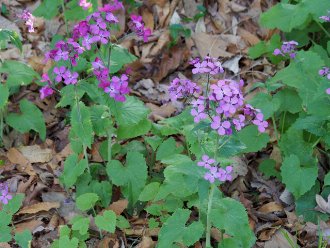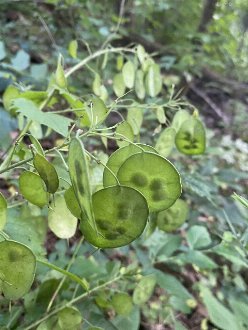Money Plant (Lunaria annua L.)
Also known as annual honesty.
↑Summary
An annual, widely planted in gardens, that has become invasive at some localities across North America.
↑Range - Expand
| Legend | Color |
| Introduced | |
| Introduced or Not Present |
This tentative map is based on our own research. It may have limited data on Canada and/or Mexico, and there is some subjectivity in our assignment of plants as introduced vs. expanded. Read more in this blog post.
Although this plant occurs somewhere in each of these regions, it may only occur in a small part of some or all of them.
Both BONAP and USDA's range maps show an unlikely discrepancy in distribution between Indiana and surrounding states, reporting this as occurring in nearly all counties in Indiana but few neighboring counties of Illinois, Ohio, or Kentucky. This discrepancy is likely a reporting error which could reflect misidentification by an individual who gathered the data, but it could also reflect a deliberate effort to locate this species, that was carried out only in that state. We have not yet investigated or resolved this discrepancy.
This species is also introduced in Canada, with a similar distribution as in the US: present on the West Coast and in the East but with a gap between. We have not yet built the portion of its range map in Canada.
↑Habitat
In its native range, this species is mostly found in woodland edges. In Europe, it has expanded its range northward, largely due to cultivation, and also taking advantage of semi-wild anthropogenic habitats including hedgerows, gardens, and agricultural land.
This species' habitat preferences in North America are not well-known. It readily self-seeds in gardens, and is occasionally found in the wild or in semi-wild areas near gardens, but, in spite of being widely planted and showing a tendency to readily self-seed in gardens, it has yet to show strong invasive tendencies in wild ecosystems in most regions. It is still listed in some sources as invasive, however. It can be locally invasive, and it may have some invasive potential in regions where it has not yet established.
It is mostly found in partly-wooded anthropogenic habitats where there is nutrient-rich, loamy soil. It requires some soil disturbance and removal of competing vegetation to establish, and in the wild it may be particular about lighting conditions, i.e. requiring some direct sunlight but also some shade.
It is possible, however, that this species is under-reported because, from a distance, it can be confused with the related and more widely-invasive dame's rocket (Hesperis matronalis).
↑Life Cycle
This plant is an annual or biennial that persists in a habitat by reseeding. In areas with mild winters, some seeds can germinate in fall and plants can persist through the winter, but most often this plant's life cycle is only a few months long, with seeds germinating in spring.
Seeds are relatively large, especially compared to other plants of this family, which, combined with the fertile soils where it tends to grow, leads it to grow and mature rapidly. Plants flower typically in April, May in the north of its range, with seeds maturing by July, or later in the north, after which point the plant dies. The large, thin, flat seed pods provide some potential for the heavy seeds to be blown over long distances by wind, but most of them fall close to the parent plant.
We could not find any research documenting its persistence in the seed bank in the wild, but inferring from gardening sources and documents on its control, it likely does not survive more than 3-4 years in the seed bank and it may not even survive that long.
↑Faunal Associations
Little is known about the relationship of this plant to fauna in North America. Long-tongued bees and butterflies visit the flowers. The only lepidoptera recorded eating this plant in the larval phase in North America is the introduced cabbage white (Pieris rapae), which eats a variety of plants in the cabbage family. Gardening sites reference it being susceptible to aphids, which we have not verified in scientific sources. It has been recorded as an accidental, but not preferred host of the introduced cabbage aphid (Brevicoryne brassicae). In British Columbia, it has been recorded by eaten by the introduced generalist black bean aphid (Aphis fabae).
↑Control
This species is usually easy to control, much easier to control than the related dame's rocket (Hesperis matronalis) and garlic mustard (Alliaria petiolata), both of which have similar life-cycles, but produce larger numbers of smaller seeds.
Plants can be uprooted by hand, which is usually easy because it tends to grow mostly in rich, loamy soil where the roots come out of the ground readily.
Removing all individuals of this plant before they produce seeds is sometimes sufficient to remove it from a site permanently. Followup may be necessary to remove new plants that germinate from the seed bank later in the season or in subsequent years, but the seed bank does not persist as long-term as with garlic mustard, so sporadic checking for 2-3 years is usually sufficient to permanently remove this plant.
↑Uses
This species was widely planted in gardens for ornamental use, where it is valued for its showy flowers and distinctive seedpods, which are sometimes dried and used in flower arrangements. Concern about its invasive potential has led it to be planted less.
↑Related Plants
Perennial honesty (Lunaria rediviva) is also introduced in North America, but it is much less-widely planted and is generally rare in the few areas where it has established in the wild.
This genus is typically put in its own tribe, Lunarieae, of the Brassicaceae or cabbage family, and is not thought to be particularly closely related to any other genera found in North America. The broader family, however, contains numerous plants, both native and introduced.
↑Links & External Resources
• Lunaria annua (Money Plant) | Illinois Wildflowers (About This Site)
• Lunaria annua (annual honesty) | USDA PLANTS Database (About This Site)
• Lunaria annua | Go Botany (About This Site)
• Lunaria annua (Annual Honesty) | Missouri Botanical Garden Plant Finder (About This Site)
• Lunaria annua | Biota of North America Project (BONAP) (About This Site)
• Lunaria annua L. | Plants of the World Online (POWO) (About This Site)
• Lunaria annua | NatureServe Explorer (About This Site)
• Lunaria annua | Flora of North America (About This Site)
• Annual Honesty | Maryland Biodiversity Project (About This Site)
• Lunaria annua Linnaeus (Annual Honesty, Money Plant, Silver-dollar) | Digital Atlas of the Virginia Flora (About This Site)







